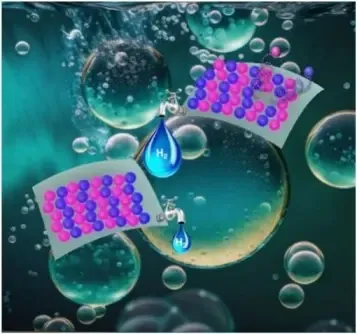
Unlocking a Cleaner Future: How NiPS3 is Revolutionizing Hydrogen Production
2024-11-26
Author: Siti
Introduction
In a groundbreaking advancement for clean energy, researchers have unveiled a technique that could significantly enhance hydrogen production efficiency through defect engineering in NiPS3 monolayers. This innovative approach, which involves strategically creating vacancies in the material, holds the promise of making hydrogen evolution reactions (HER) more efficient and cost-effective, potentially reshaping the landscape of renewable energy.
The Role of Hydrogen in Clean Energy
Hydrogen is set to play a crucial role in the transition to clean energy, primarily as a hydrogen fuel source. However, existing catalysts like platinum are extremely costly, prompting the search for viable alternatives. Transition metal phosphorus trichalcogenides, particularly NiPS3, have emerged as highly promising candidates due to their unique structural properties. Despite their potential, the practical application has been hindered by inherent limitations such as low catalytic activity and an inert basal plane. To address these challenges, innovative defect engineering techniques are needed to enhance the material's effectiveness.
Research Breakthroughs
A research team from Konkuk University has made significant strides in this field. Their recent study, published in eScience in June 2024, employs first-principles density functional theory (DFT) to investigate various defect configurations within NiPS3—including singular Ni vacancies, S vacancies, and even combined NiS vacancies. The findings reveal that the dual introduction of Ni and S vacancies drastically reduces activation energy and facilitates water dissociation and proton adsorption, making NiPS3 a strong competitor to platinum in HER applications.
Mechanisms of Enhancement
This study provides an in-depth look at the mechanisms behind these enhancements. The researchers discovered that S vacancies significantly aid in water adsorption, while Ni vacancies create stronger interactions with the resulting protons after dissociation. The highest efficiencies were observed with co-created NiS vacancies, leading to exothermic reaction pathways and free energy changes comparable to those found in platinum catalysts. Moreover, electronic structure analyses showed that the introduction of vacancies dramatically influences the local density of states (LDOS), optimizing thermodynamics and reaction kinetics.
Expert Perspective
Lead researcher Prof. Ki Chul Kim expressed optimism about these findings, stating, “Defect engineering on NiPS3 opens new frontiers in hydrogen evolution catalysis. Our results underscore how strategically designed atomic vacancies can markedly enhance catalytic efficiency, paving the way for scalable and economically viable hydrogen production.”
Broader Implications
The implications of this research extend beyond hydrogen production; they potentially affect a variety of catalytic processes, including oxygen reduction and CO2 reduction. With further research and development, NiPS3 could bring about significant advancements in clean energy technologies, thus accelerating the global transition towards a sustainable hydrogen economy. This initiative not only sets a new standard in the material science domain but also highlights the transformative power of atomic-level engineering in tackling tomorrow's energy challenges.
Conclusion
As the world looks to reduce carbon footprints and shift towards renewable energy sources, the optimization of materials like NiPS3 may play an instrumental role in achieving these ambitious sustainability goals. Keep an eye on this exciting development as it could mark the beginning of a new era in energy production.
Stay Tuned
Stay tuned for more updates on revolutionary breakthroughs in hydrogen production!


 Brasil (PT)
Brasil (PT)
 Canada (EN)
Canada (EN)
 Chile (ES)
Chile (ES)
 España (ES)
España (ES)
 France (FR)
France (FR)
 Hong Kong (EN)
Hong Kong (EN)
 Italia (IT)
Italia (IT)
 日本 (JA)
日本 (JA)
 Magyarország (HU)
Magyarország (HU)
 Norge (NO)
Norge (NO)
 Polska (PL)
Polska (PL)
 Schweiz (DE)
Schweiz (DE)
 Singapore (EN)
Singapore (EN)
 Sverige (SV)
Sverige (SV)
 Suomi (FI)
Suomi (FI)
 Türkiye (TR)
Türkiye (TR)